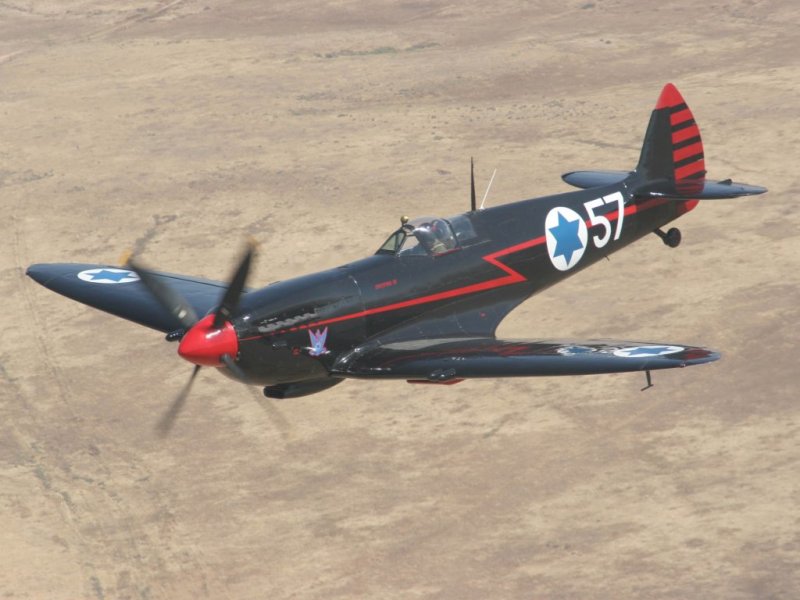
From an original article by Nadav Berger | Translation: Ofri Aharon – Israeli Air Force/IAF Magazine.
After a four year absence and a very detailed overhaul process, last May the “Black Spitfire of Ezer Weizman”, the oldest, most famous of Israeli airplanes, returned to the skies.The airplane was completely disassembled and reassembled in cooperation with Israeli Air Force’s Transport Branch, the IAF Museum, The Ministry of Defense and other IDF Units. Many parts of the plane were replaced including the radiators, gas pumps, tires and upholstery, some of the parts were shipped in from shops in Britain and Germany. The “Black Spit” joined the Royal Air Force in May 29, 1945, was transferred to the Czech Air Force and then sold to Israel in October 1948.The plane arrived in Israel in November 1949, received the number 2057, and entered service in the “First Fighter” Squadron. It was then used for training purposes in the “Scorpion” squadron and the “Third Spitfire” Squadron, known today as the “Knights of the Orange Tail” Squadron ( now flying F-16I Sufa). In 1954, most of Israel’s Spitfires were sold to Burma, but a few planes remained in Israel at the initiative of Major General Ezer Weizman, the then-Commander of Ramat David Airbase. One of those planes was Spitfire 2057 (or 57 after shortening) which shortly afterwards became Weizman’s private plane and was painted black at its command to resemble the plane of the British Airbase Commander under which Weizman served during WWII. Weizman stuck with the “Black Spit” even after completing his army service and kept flying it in IAF’s airshows. Wiezman’s association with the plane was so great that it was decided to fly it over cemetery, during his funeral.
The story of Spitfire 57
The story of Spitfire 57, also known as, “Ezer Weizman’s Black Spit”, should be told from the middle, rather than the beginning. Not from its first days during the Second World War and not from the day it took off once again into the blue skies six months ago, rather from the moment that kept the Spitfire alive, when it was decided to keep it in Israel. During WWII, the late Ezer Weizman that later served as the Commander of the IAF and President of Israel, was posted in the Royal Air Force’s Faeed Airbase in the Sinai Peninsula, where the airbase commander flew a painted black Spitfire. Weizman remembered the uniquely painted plane, and in 1954, while serving as Ramat David Airbase Commander, after it was decided to sell most of the Spitfire airplanes owned by the IAF to Burma, he requested that Israel kept one for its legacy and no less, for his own use.”A Commander should have a unique characteristic in order to stand out. Such a personal identity sticks to the commander and accompanies his path and becomes a sort of identity card”, wrote Weizman in his autobiography. “‘The Black Spitfire’ was that characteristic that made me different, it was recognized in the entire IAF… it was an airplane that smelled of history. Both in WWII and in our ‘small war’, the War of Independence, to a large extent it determined the outcome of the aerial wars”. The “Black Spit” accompanied Weizman to every place and even after he retired, the former commander continued to fly ‘Black Spit’ in different aerial demonstrations in which the airplane still takes part today: Independence Day celebrations, Jewish holidays, Wing ceremonies and special aerial demonstrations.
Thus, it was only natural that during Weizman’s funeral in April 2005, it was decided to conduct a “Black Spit” flight over the cemetery where he was buried.
From Britain to “Hatzerim”
Up until now, this was the middle of Weizman’s story, let’s backtrack to the beginning. During the 1948 War of Independence over Israel and the foundation of the young air force, every airplane that could partake in the war in any manner was essential; airplanes were being constructed in the basements of vineyards in Tel Aviv. One of them was the D-130 which was given the name “Israel 1”. This airplane, which was used for patrol and photography, was made up of pieces from older Spitfires that were left behind by the RAF after the British forces left the country and from Egyptian Spitfires that were brought down by Israeli forces. On July 23, 1948 the “Israel 1” airplane took off as the first Israeli plane to join the war effort and later the D-131 joined, an additional Spitfire plane that was built in a similar manner.Dozens of additional Spitfires were purchased throughout the War of Independence from Czechoslovakia and successfully took part in the war efforts and downed 12 enemy airplanes. 30 more Spitfires were purchased from Italy after the war. Spitfire 57 was one of the airplanes purchased from Italy. In November 1949, it arrived in Israel, received the tail number 2057 and became a part of the “First Battle” Squadron. Later it was used for training in the “Scorpion” Squadron and “The Third Spitfire” Squadron (Today “Knights of the Orange Tail” Squadron – now flying F-16I Sufa). When the model went out of service in the IAF, it was chosen to be the airplane that would be saved for the late Weizman and was renamed the “Black Spitfire”.At the end of the 1970’s, the airplane was transferred from Ramat David Airbase to Hatzerim and later to the Air Force Museum, in which it still stands to this day and continues to fly for festive aerial demonstrations. Since the 1990’s, when Weizman was still alive, the task to fly the airplane was given to Colonel (res) Dani Shapira and Colonel (res) Oded Rosenthal.
One of 60

- (Image Credit: Andreas Zeitler)




























